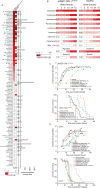Establishing a Preclinical Multidisciplinary Board for Brain Tumors
- PMID: 29301833
- PMCID: PMC5884708
- DOI: 10.1158/1078-0432.CCR-17-2168
Establishing a Preclinical Multidisciplinary Board for Brain Tumors
Abstract
Purpose: Curing all children with brain tumors will require an understanding of how each subtype responds to conventional treatments and how best to combine existing and novel therapies. It is extremely challenging to acquire this knowledge in the clinic alone, especially among patients with rare tumors. Therefore, we developed a preclinical brain tumor platform to test combinations of conventional and novel therapies in a manner that closely recapitulates clinic trials.Experimental Design: A multidisciplinary team was established to design and conduct neurosurgical, fractionated radiotherapy and chemotherapy studies, alone or in combination, in accurate mouse models of supratentorial ependymoma (SEP) subtypes and choroid plexus carcinoma (CPC). Extensive drug repurposing screens, pharmacokinetic, pharmacodynamic, and efficacy studies were used to triage active compounds for combination preclinical trials with "standard-of-care" surgery and radiotherapy.Results: Mouse models displayed distinct patterns of response to surgery, irradiation, and chemotherapy that varied with tumor subtype. Repurposing screens identified 3-hour infusions of gemcitabine as a relatively nontoxic and efficacious treatment of SEP and CPC. Combination neurosurgery, fractionated irradiation, and gemcitabine proved significantly more effective than surgery and irradiation alone, curing one half of all animals with aggressive forms of SEP.Conclusions: We report a comprehensive preclinical trial platform to assess the therapeutic activity of conventional and novel treatments among rare brain tumor subtypes. It also enables the development of complex, combination treatment regimens that should deliver optimal trial designs for clinical testing. Postirradiation gemcitabine infusion should be tested as new treatments of SEP and CPC. Clin Cancer Res; 24(7); 1654-66. ©2018 AACR.
©2018 American Association for Cancer Research.
Conflict of interest statement
Figures






References
-
- Gilbert MR, Sulman EP, Mehta MP. Bevacizumab for newly diagnosed glioblastoma. N Engl J Med. 2014;370:2048–9. - PubMed
-
- Krueger DA, Care MM, Holland K, Agricola K, Tudor C, Mangeshkar P, et al. Everolimus for subependymal giant-cell astrocytomas in tuberous sclerosis. N Engl J Med. 2010;363:1801–11. - PubMed
Publication types
MeSH terms
Substances
Grants and funding
LinkOut - more resources
Full Text Sources
Other Literature Sources
Medical

